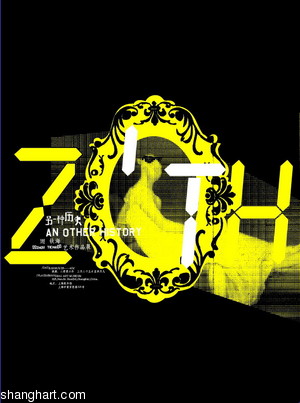Zhou Tiehai
dal 24/3/2006 al 8/4/2006
Segnalato da
24/3/2006
Zhou Tiehai
Shanghai Art Museum, Shanghai
An Other History. This exhibition presents forty of the most important works created by the artist in the seventeen years between 1989 and 2005. He will offer the viewer an outspoken, rich, lively, colorful and emotional display.His works "Are You Lonely?" "Fake Cover Series," "Will - Bixu" have left a lasting impression on contemporary art. Curated by Zhang Qing.

An Other History
An Other History: Works by Zhou Tiehai will be on display from March 25 through
April 9, 2006 at the Shanghai Art Museum, curated by Museum deputy director and
Shanghai Biennale Chief Coordinator Zhang Qing. This exhibition presents forty of
the most important works created by Zhou Tiehai in the seventeen years between 1989
and 2005
Zhou Tiehai was born in Shanghai in 1966 and still resides there today. In recent
years, he has become one of the most important Chinese artists active in the
international contemporary art world.
He is a wave-maker and a trend-setter, having gained the attention and support of
internationally significant collectors, curators and critics and been recognized as
a spokesman for new artistic concepts.
Zhou Tiehai works in opposition to prevailing norms, from the rebellious gestures of
his youth to his more recent oppositional stance toward the global art world. In
1994 he began to analyze and daringly critique not only the art world writ large but
his own position within that world, remaining critical throughout. Like the saying
that "the hard thing is to stay good for a whole lifetime," Zhou is a special case,
having been engaged throughout his career in the similarly difficult work of
maintaining a consistent position, offering at every turn a timely and relevant
critique of the development of contemporary art even as others were defeated or fell
out of the game. In the end, Zhou offers nothing less than a line parallel to that
of the development of contemporary art itself.
As stated, Zhou Tiehai has taken this oppositional stance, offering accurate
critique and analysis whenever a problem presents itself in the art world. So,
speaking concretely, his technique remains stable from work to work as his emblems
remain clear. Yet, from the perspective of the course of art, he is undoubtedly
versatile, his emblems stronger than other artists, taking and deconstructing, for
example, that most widely known logo of Western civilization Joe Camel in his
"Camel" series, or his "Placebo" series. In other works, he uses modern jet-printing
techniques to render traditional Chinese landscape paintings, expressing his own
woes about the newly fashionable ancient Eastern civilization in his "Chinese
Painting Series" -"Tonic". His "Movie Stars of the1980s" series speaks to the
nostalgia for a decade when each day promised to be better than the last. For Zhou,
painting, installation, video and sculpture are merely different "toys," and his
choice of medium is often approached from this disposition. With his working
philosophy of being "the master of his own domain," he makes sensitive, nervous
choices, retaining all the way the enthusiasm, innocence and responsibility of a
child. All the while, he plays the role of an independent-minded artist offering
unique insight into art, the world, and humans generally. For this reason, rarely do
others dare to imagine themselves as insiders in this private realm.
His works "Are You Lonely?" "Fake Cover Series," "Will - Bixu," and others have left
a lasting impression on the history of contemporary art.
However, no matter which words we use to describe them, these works retain a
photographic quality, Zhou Tiehai's ability to compress a rich and vivid life onto a
flat surface. His artistic process has already decided upon the impossibility of
using monikers and epithets to depict his subjects. We could say that Zhou is a
strategist, because he understands that historical development always entails the
possibility of interaction and commingling between contradictory sides. Rebels, if
they remain rebels, often become unifiers. On one level, perhaps this is also a
function of necessity, and one that Zhou Tiehai plays to great effect. We might say
that Zhou Tiehai is an elusive genius, whose sagacity and humor permeate at every
opening. A classic example of this is the work he exhibited at the 2004 Shanghai
Biennale, "Airport," in which he broadcast the sounds of an airport across the
exhibition venue, such that in every corner of the museum, one could hear a
disembodied voice announcing departures to cities all over the world. This
inescapable work stimulated each and every viewer, and affected every single work on
display. We can narrate the work and the persona of Zhou Tiehai from many
perspectives, but in the end, he can only become the Zhou Tiehai of an "other
history."
In this exhibition, the artist will offer the viewer an outspoken, rich, lively,
colorful and emotional display. The art-going public in Shanghai will gain from it a
sense of both the reality of an alternative history and its potential.
Shanghai Art Museum
325, West Nanjing Road - Shanghai



